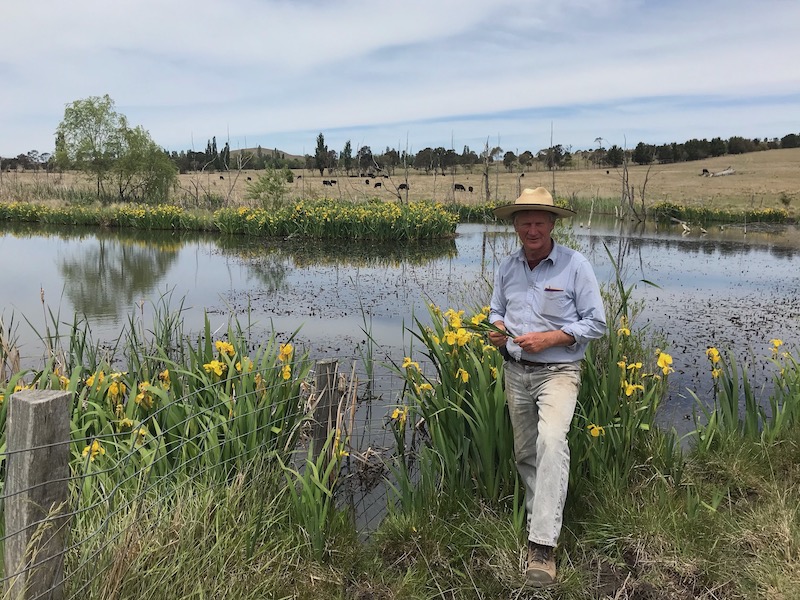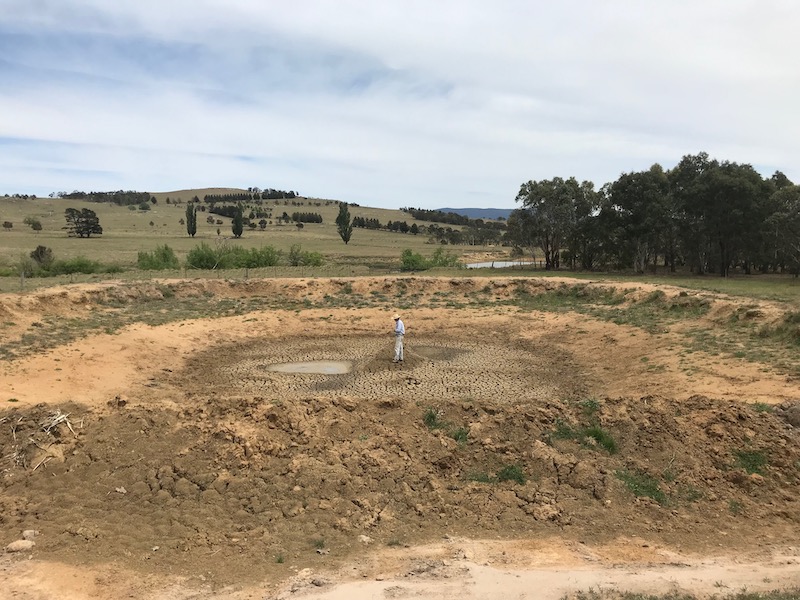
Martin Royds near one of his weirs which is brimful despite the ongoing drought. Photos: Supplied.
Beef cattle farmer Martin Royds will supply Braidwood with back-up water should the Shoalhaven River run dry, an astonishing offer in this drought.
“My prediction is, if something does not happen dramatically in the next two months, the Shoalhaven will run dry,” Mr Royds said. “And Braidwood, which pumps out of the Shoalhaven, will be in a pickle. I have at least six mega-litres in one of my weirs which I can pump into the Braidwood storage tank and supply Braidwood with water.”
Mr Royds is one of a rising number of farmers in the Braidwood district practising regenerative farming, promoted by the ABC’s Australian Story’s series on farmer Peter Andrews’ drought-proofing.
At ‘Jillamatong’, most of Mr Royds 34 dams (which he calls “evaporation dishes”) are bone dry. But 14 major weirs built over the past 10 years across erosion gullies are holding on to water. Some are brimful.

One of the dams Martin Royds calls an evaporation dish.
He is not feeding his cattle and doesn’t expect to. “We just keep de-stocking to the amount of feed we have on the ground. The last three months we have been selling 20 per cent, 30 per cent and 50 per cent this week of the remaining mob,” Mr Royds said.
“The difference is, they go off fat, so you get a premium for them. Skinny cattle in a drought are not worth anything. Fat cows should get even more than what they are getting, but at least they’re a premium.”
Mr Royds says the aim of regenerative agriculture is to leave the land in a better state, the tools used are up to the individual. He uses everything he can get his hands on: author Charles Massey’s ‘The Call of the Reed Warbler’; the neighbouring Mulloon Institute; Peter Andrews; and Allan Savory’s Holistic Management.
“When growing up we were taught no weeds, no trees, bare paddocks, a mono-culture of rye grass or clover. My new learning is that the more biodiversity in the soil, the better and the more diverse the surface helps that, more biodiversity in businesses helps again. So, we just focus on biodiversity in everything, so that’s our goal. Every decision you make, is that building biodiversity? Is that building soil?” he said.
Neighbours Mulloon Creek Natural Farms, and the Mulloon Institute established by the late Tony Coote, are other advocates of regenerative farming.
Mulloon Creek Farms manager Michael Fitzgerald says they are not telling others what to do, but looking for solutions.
Farmers are torn between hanging on to their animals and farms, or selling.
“We get into a vicious cycle in farming. People make the best decisions they can at the time,” Mr Fitzgerald said. “In Australia, we have enough rainfall, we are learning how to hold that better.”
Mulloon de-stocked their cattle by one-third at the beginning of the year and are coming into the warmer season with 100 breeder cows and their pellet-fed poultry. Mobs of kangaroos and deer are competing for pastures.
“We have reasonable ground cover, but the pastures are starting to deteriorate as the year progresses,” Mr Fitzgerald said. “We are still 100 mm behind where we should be. That may not sound a lot to other producers in different climate conditions, for us and given our soil type it has a big effect. With granite soils, we tend to lose our rainfall, it soaks in quickly.”
Leaky weirs established from 2006 when Tony Coote arrived are paying dividends, as water continues to arrive despite no rain.
“It is not coming in at the top of the system, it is coming from our storage in the floodplain,” Mr Fitzgerald said. “There is water just trickling over the rocks down at Peter’s Pond and Peter’s Weir. It is only just seeping through, but it is still moving and it is quite amazing there is still water.”
Leaky weirs have been established for three kilometres, and 20 landholders are taking the project further beyond Mulloon farms to hold water and build a better bank of water in the wider catchment.
“We need to fall in love with our grass, not our animals, which is very hard, because we all love our animals,” Mr Fitzgerald said. The work is ongoing outside of the floodplain, and is as effective managing water after rain falls. “When it does come, we need to grab it and hold on to it,” he said.












